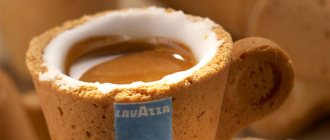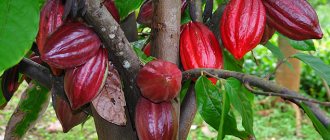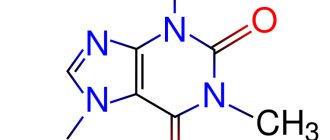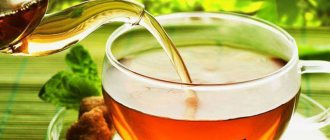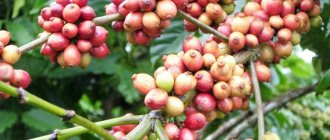Buying the finest quality Costa Rican coffee, lovers of this drink become familiar with its exquisite taste. In the state of Costa Rica, located in Central America, it is prohibited to grow robusta. All industrial agriculture is engaged in the production of selected Arabica beans.
Costa Rican coffee contributed to this country gaining a new status, since the middle class of the republic was made up of coffee plantation owners. Namely, at one time he took up the transformation of his native state: he contributed to the establishment of democracy and the formation of order.
Today, Costa Rican coffee beans are highly prized throughout the world. And the local budget income from the export of this product is 30% of the total state profit from goods sold abroad.
Although even before the 18th century. in this part of America they had never even heard of coffee trees. And only three hundred years ago this plant first settled on Costa Rican plantations. A fairly hot climate, reasonable rainfall, soil mineralized by volcanic substances and high-quality high-mountain air contributed to the rapid growth of coffee in Costa Rica.
Costa Rica began trading directly Arabica coffee with all countries of the world only in the 40s. last century. And today it sells 90% of the harvest abroad.
The best Costa Rican coffee, grown at an altitude of 1500 m above sea level, is labeled as SHB (strictly hard bean).
Characteristics of Costa Rican coffee
Coffee grown in Costa Rica is rightfully considered the best among the best in the world. Products from the Tarrazu region are especially valued, where about 35% of the country's total coffee production is produced. The Starbucks chain buys it.
According to the description of knowledgeable experts, the aroma and taste of the future drink depend on the region of cultivation of Costa Rica coffee and the further processing method:
- the “wet” method of grain processing makes it possible to obtain a softer drink (with the presence of honey, fruity flavor, diluted with a “note” of milk chocolate);
- “dry” processing gives the drink a citrus taste, with a berry “note”;
- honey processing removes the sourness from the finished coffee, imparting additional sweetness with a “note” of molasses.
Every year the republic hosts the “Cup of Excellence” – a coffee competition. The most popular Costa Rica coffee brands according to gourmet reviews: Doka Estate, La Minta, others.
Costa Rica grows high-caffeine Arabica beans. After all, this is the only place in the world where climatic and geographical conditions allow the production of this variety, subject to all appropriate requirements.
The unique taste of the famous Costa Rican coffee is due to its genetic purity. Arabica from Costa Rica is the best coffee, which has deservedly conquered the most sophisticated gourmets around the world.
Typica
This type of coffee is considered the first known. From it, thanks to natural mutation or genetic changes, all the others then descended. It spread around the world with the help of the Dutch, who chose Typica for commercial production. Its fruits are usually red. The yield is relatively low compared to other varieties. The coffee made from them has an excellent taste. The cultivation of Typica is becoming increasingly popular in various parts of the world, and therefore we also know this variety under the names Criollo, Sumatra and Arabigo.
Costa Rican coffee classes
- SHB or Grown Mountain is the best product category;
- GHB – fairly good quality;
- HB or Hard Bean Medium (MHB) has good quality indicators based on the height of the growing plantations (900-1200m);
- LGA – labeling of Costa Rica lowland coffee.
The product class directly affects the formation of its cost. The average price of roasted grain (per 1 kg) is 1800 rubles.
Arabica from the Tarrazu region is considered the best in the world. The following varieties are known:
- Marcos;
- Sarchi;
- La Minita Tarrazu is hand-sorted;
- Britt is sorted and cleaned by hand and has a low caffeine content.
Processing process
Typically, the harvested crop here is subjected to wet processing: to separate the pulp, it is soaked in water and then cleaned under running water. Now the unique “honey” method of cleansing is becoming increasingly popular. In essence, these are half-washed fruits from which the pulp is not completely removed. Particles of fragrant dried berries add different flavor notes to the finished drink. Planters are constantly experimenting with the percentage of pulp on the grains:
- “white honey” contains up to 10%;
- “yellow” - up to 50%;
- “red” - from 50%;
- “black” - the pulp remains completely.
The lighter the “honey,” the more sourness in the taste, the darker it is, the sweeter and more aromatic it is.
It is customary to fry here with the addition of sugar, which gives the drink a nutty flavor.
Costa Rican coffee
Just like live coffee from Brazil, varieties from Costa Rica can be brewed in many ways:
- Using any filter (through which hot water passes).
- In a capsule coffee maker.
- In this case, you will need a French press.
- A great way is in an espresso machine.
- Pour boiling water over the ground grains and let the drink steep under the lid (an affordable option for home preparation in the absence of specialized equipment).
The degree of roasting may vary. It is difficult to spoil Costa Rican coffee using any of the brewing methods presented.
The traditional recipe for making a drink in Costa Rican does not involve the use of a Turk or other devices:
- coffee beans – 1 tsp;
- water – 100 g.
A filter is made from gauze and placed on the surface of the cup. Crushed grains are placed on it. I pour boiling water through this device. The drink in the cup is the national coffee of Costa Rica.
What to buy
In this section, I will talk about traditional souvenirs that tourists can buy in any region of Costa Rica.
Food and alcohol
Despite the fact that Costa Rica is far from us and the journey home takes up to 24 hours, the most popular type of gifts is “edible”. Fortunately, they all have a long shelf life, so they will be delivered to our region in the best possible condition.
Coffee
In many Latin American countries, coffee is the No. 1 product. However, in Costa Rica it has also acquired premium status. The country officially allows the cultivation and sale of only one variety - Arabica, and only the highest SHB standard - “strictly hard grain”. These beans can be roasted at extremely high temperatures, giving the coffee an indescribable aroma.
How to choose the right coffee
If the cost of a pack of bean coffee starts from 12 USD, then ground coffee can be found for 5. As a rule, tourists are attracted by the low price and buy coffee that is ready for brewing. However, I would advise such travelers to reconsider their view of this product. The Costa Rican government has strict rules on how the beans can be grown and cultivated, but has said nothing about what “additional ingredients” can be added to packets of ground coffee. I don’t know exactly what tricks Costa Rican producers go to in this case, but in Cuba, for example, crushed peas are added to ground grains for these purposes. These “organic additives” reduce not only the price, but also the amazing aroma of the drink. Therefore, if you want to please your loved ones with real, elite Costa Rican coffee, buy it only in beans.
The next question is the brand of coffee. The most popular brand in Costa Rica is Café Britt, which you can buy literally everywhere. You can also try it in any cafe and, if you like the coffee, take it and don’t waste time on further thoughts. However, for the ardent coffee fans, I will delve a little deeper into this topic.
Costa Rican coffee brands can be divided into two large groups.
The coffee that is exported is famous for its exceptionally premium quality - after all, Costa Rica, like many other countries, likes to “show off”. These brands include Café Rey, Dota and Naranjo. These names are rarely found in supermarkets, so the easiest way to buy them is in the following ways:
- On the plantations themselves, where excursions for tourists are regularly held. Certain brands can only be purchased at coffee farms, as they are exclusive brands of large chain coffee shops (for example, Café Doka Estates, which exclusively supplies its beans to Starbucks). Prices for premium coffee at the point of production start from 15-20 USD per package.
- In souvenir shops. The price here will be much more expensive - from 25-30 USD per pack of grains.
Local brands, which are mainly purchased by Costa Ricans themselves, will be much simpler, but also noticeably cheaper. This section includes all the brands that you can find in the supermarket - I will not list them, since they may be different in each region. Mostly locals buy ground coffee, but there is a good selection of beans. Prices for bean coffee in supermarkets start at 12 USD per pack.
History of Costa Rican coffee
Arabica beans first appeared in Meseta Central, a region of the Costa Rican state, back in 1779. Gradually, with the support of the government (farmers received loans for business development), coffee production in Costa Rica increased. The ideal natural conditions of this republic played an important role in increasing the volume of production.
At the beginning of the 19th century. On the territory of Costa Rica there were entire systems of coffee plantations. And just 30 years later, this product became the main source of income for the country, relegating cocoa, sugar and tobacco to the background.
During this period, Costa Rica, following the example of other Spanish colonies, declared its own independence. And in the 30s of the XIX century. established the export of coffee beans to Chile and Great Britain. By the way, the United Kingdom was the main buyer of Costa Rican coffee until World War II. The Kingdom, interested in constant supplies of quality goods, has invested heavily in the development of the Costa Rican coffee industry.
The country's profits covered more than just improvements in agricultural technology. It was enough for the development of other areas: the construction of the railway, the construction of the National Theater in the capital, and the transfer of many other areas of life in Costa Rica to a higher quality level. This has helped coffee farmers become the most respected members of society.
In the middle of the 20th century. A customs duty was introduced on coffee. In 1983, numerous plantations were attacked by a pathogenic fungus, destroying future harvests. This disaster led to a crisis in coffee production that lasted about 7 years.
Are mocha and mochaccino the same thing or not?
Some people incorrectly believe that we are talking about different things. Indeed, there is such a type of coffee - mocha, which is a variety of the famous Arabica. But there is also a drink of the same name. When some coffee shops offer you the coffee dessert mocha (or mocha), and others offer you mochaccino, the recipe for both drinks is similar. We are talking about the same coffee dessert. Only the name “mochaccino” is more often used in European countries, and the more abbreviated name “mocha” or “mocha” can be found in America. In Russian coffee shops, both pronunciations are found, but they mean one drink.
Interesting facts about Costa Rican coffee
- The Republic of Costa Rica has the highest coffee production in the world - 1,600 kg per hectare (56,438 ounces).
- 80 thousand farms of various levels are involved in the state's coffee industry.
- Most types of Costa Rica coffee are certified as “bird-friendly” - a high degree of environmental safety of the product for the environment (the planet’s ecosystem is not disturbed, since birds can nest on the trees around the plantations).
- Coffee from Costa Rica is of the highest quality, the highest quality product in Central America.
Making cappuccino
Let's take a closer look at how to make cappuccino. There are two options for creating this drink - with or without a coffee machine. The process itself, in any case, consists of several stages:
Brew espresso coffee
This can be done either in a coffee maker or in a Turk or cezve, the main thing is to choose high-quality coffee. It’s easier with a coffee machine, load the beans and wait for the result.
If you prepare espresso in a Turk, then you need to take ground beans and add water. Place the Turk on medium heat and wait a bit. The main thing is to prevent the contents from boiling, since the resulting drink will be too bitter.
As soon as the foam begins to rise, the Turk needs to be removed from the stove. The foam will settle, then put the coffee on the fire again. Experts recommend doing this procedure at least five, and preferably seven times; the more, the stronger the drink. Now the espresso is ready and you can proceed to the next stage of making cappuccino at home.
Making milk foam
Some coffee makers mix milk with cream, but ideally the foam should be whipped only from milk, and natural milk at that. To do this, you need to take milk with a higher fat content, since it whips into foam more easily. If your coffee machine is equipped with a cappuccino maker, then you're in luck. Pour milk into a container and whisk it using a cappuccino maker.
If it is not available, you can beat the milk with a mixer, whisk, blender, or French press. These methods are more labor-intensive and time-consuming, but they fully replace a cappuccino machine. The milk must first be heated and then whipped using one of the above methods.
The whipping process may seem useless, but you need to be patient and not torment yourself with the question of how to make cappuccino at home. We continue to beat persistently. First, large bubbles begin to appear in the milk. But they are not suitable for us, we continue to beat until a fine, dense foam appears. The milk foam is ready and you can arrange it to meet the espresso.
Combining coffee with foam
For the drink, you need to prepare a porcelain or ceramic cup. Before pouring coffee, the cup must be heated by rinsing it with boiling water. Now pour espresso into it, and use a spoon to add airy milk foam on top. Coffee and foam are taken in a 1:1 ratio. Just don't stir it.
Some coffee makers add not only foam, but also milk to classic coffee. In this case, the cup is filled ⅓ with each ingredient (coffee, milk and foam). First, pour coffee into the cup ⅓ full, and then fill the center with a thin stream of another ⅓ cup with milk. You need to pour it out of the container in which it was whipped, then first the unwhipped milk will carefully pour into the drink, and then a smooth milk-foamy cap will lie on top.
Depending on the pouring technique, you can prepare a white or black cappuccino. The preparation of black cappuccino was described above. The white drink is prepared by first pouring milk and only then coffee into a heated cup. Believe it or not, the taste of white cappuccino is practically no different from black.
Our cappuccino is ready for coffee drinking. Some don’t stop there and manage to apply some kind of design onto the foam.
Cappuccino decoration
In coffee shops, baristas do this, but why are we worse? Baristas usually draw using special stencils using cocoa powder and other spices. This art is even called latte art. The art of drawing on coffee foam is based on only three images: an apple, a heart and a flower (rosetta), while the rest of the drawings are made on the basis of these three. Therefore, in order to beautifully draw cappuccino foam, you just need to learn how to make the basic shapes, and then use your imagination.
Cooking tricks
To make your cappuccino perfect, it is important to follow a few tricks:
- For foam, we take only natural milk with a fat content of at least 2.5%, cream should be 30% fat.
- Sugar. Some people recommend putting it in the coffee before pouring in the milk and foam, some recommend whisking it with milk, and some recommend sprinkling it on top of the foam. It's up to you, but ideally the foam is sprinkled with sugar.
- Important point. Both the milk with foam and the coffee itself must be hot at the time of connection, as is the cup into which they are poured.
- If you intend to make a cappuccino with rum, cognac or liqueur, then they need to be added before adding the foam, but nut or chocolate chips or cinnamon should be sprinkled only on the foam.
Production
Under the current reality, the volume of coffee grown in Costa Rica is directly dependent on low-paid seasonal labor. Farmers everywhere hire cheap labor from economically undeveloped countries. In this way, they simultaneously save their own money and provide work to the unemployed population.
Today, coffee beans are processed in the following ways:
- The skins are removed from the still fresh fruit and its pulp is removed - the “wet” method;
- dried grains are cleaned by removing the pulp - the natural or “dry” method;
- the skin is removed from the still fresh fruit, and the pulp is removed after drying the beans in the sun - the honey or “semi-dry” method (the coffee acquires a special aroma and natural sweetness).
The republic is home to the IWCA, a representative office of the international alliance. Its activities are aimed at supporting the female population who are employed in the coffee industry.
The organization defends their rights, including equal pay to men. The main principle of the alliance is to credit the woman’s account with the earnings of the entire family, a farmer employed in the coffee growing industry.
Unraveling the secret of taste
After trying this coffee once, you shouldn’t rush to conclusions. Its taste is so diverse and rich that each person finds something of his own, something that the other could not taste. Some people hear creamy notes, while others hear a floral bouquet. Of course, the taste of coffee is influenced by various factors, such as the degree of roasting, grinding, storage conditions, and brewing method. If the grinding, brewing and storage of grains can be regulated, then with the place of growth everything is different. The taste of maragogip directly depends on where it grew and now we will reveal the 5 main secrets of this coffee:
2. Mexico and Colombia offer coffee with a delicate nutty-chocolate flavor. Some people call this flavor sharp, but true gourmets find something unusual in it.
3. And the best beans are those grown in Guatemala. Moreover, they not only look perfect in appearance, but also have a harmonious taste.
4. Grains do not have a stable taste, and it directly depends on the soil composition. If there is a lot of iodine in the soil, then the drink will taste like medicine. The plant, like a sponge, absorbs all the odors of the area, which is why the aroma and taste indicators can vary greatly.
5. It is rarely consumed in its pure form; it is most often used to create mixtures if they want to give the drink a specific taste and smell.
Grain maragodzhip has a porous structure, which allows it to absorb any odors well. This allows you to create flavored coffee based on it.
Coffee secrets of Costa Rica
Coffee beans on Costa Rican farmlands ripen at a temperature comfortable for the fruit tree – 17-23 °C. This is possible due to the location of coffee plants in the shade of fruit plantings. This way the coffee matures faster and is of better quality. Its taste characteristics improve and the caffeine content increases.
The coffee business in Costa Rica is established under strict adherence to the rules and regulations characteristic of quality production. Its activities are regulated by Producer Associations, as well as the National Coffee Institute. Everyone benefits from this: farmers, consumers, production workers and the state.
Advertising of Costa Rican coffee in international markets has been established. In Costa Rica, thematic and presentation coffee festivals are held at a high level. Tourists can take part in specially organized trips along routes laid out in the regions where the national wealth of the republic is grown.
Arabica
The Arabian coffee tree, Arabian coffee or simply Arabica (lat. Cofféa arábica) is the most popular type of coffee tree, most varieties of which appeared as a result of natural mutations or crossing varieties such as bourbon and typica. Less known is maragojip (elephant grain), which is distinguished by its large grain size.
Arabica trees can grow up to 8 meters in natural conditions, up to 5-6 m in cultivation, but on plantations they are pruned to 2-3 m to facilitate manual picking of the fruits. Arabica varieties are grown in the mountains at an altitude of 900 meters above sea level, where the average annual temperature is +15-24 degrees. Quite a few countries are cultivating Arabica. But the main producers supplying coffee to the international market are Brazil, India, and Indonesia. There are small Arabica plantations in Australia.
Features of growing Arabica in an apartment
You can read more about growing coffee in an apartment here: https://uralferm.ru/ekzotika-doma/kofe/vyraschivanie-kofe-v-kvartire. This article describes the features of growing the varieties in question.
The height of fruiting Arabica at home can reach 1.5 m, the tree is not afraid of pruning and can be safely shaped as it is convenient for the owner. If the goal is to obtain coffee beans, it is better to grow the tree in a floor tub, forming a fairly wide crown.
In an apartment or house, the dwarf variety of Arabica Nana (Cjffea arabica NANA) grows well - a small tree (up to 85 cm), which can be easily shaped by pruning and pinching. With good care it can bloom twice a year.
Lighting. For regular fruiting, you need a lot of light, so the plants are best suited for windows facing south, southwest, southeast, or the plants need to be provided with additional lighting. Young seedlings and trees at the stage of ripening berries must be protected from direct sunlight. If you don’t want to get fruit in winter, you can do without additional lighting. The plant tolerates a lack of light well, grows well in northern and northwestern windows, but without fruiting.
The soil. Coffee trees are not too demanding on the soil, the main thing is that it must be acidic and sufficiently moist. The soil composition should include peat, as well as organic fertilizers, for example, humus. To maintain moisture and aeration, it is good to add sphagnum moss to the mixture.
Watering and fertilizing. During the first 3 - 4 years, coffee is transplanted into larger pots as it grows, adding new nutritious soil to them, so fertilizing is not required during this period. Next, organic and mineral fertilizers are used. When watering, it is recommended to slightly acidify the soil (add a few drops of lemon juice to the water).
Diseases and pests. Arabica is the weakest variety in terms of diseases and pests. But it should be noted that home-grown coffee suffers from disease and insect attacks very rarely. Read more about diseases and pests of coffee in the articles: Coffee Diseases and Coffee Pests.
Arabica coffee
Coffee made from Arabica beans has an excellent aroma and complex taste with a specific acidity. Often the final product contains only a single variety or is mixed with robusta. Fresh beans contain about 1.5% caffeine, 18% aromatic oils, 13% protein, 8% sugar (up to 3% in processed beans), 12% fat. The amount of alkaloid that stimulates the central nervous system depends on the variety, climatic conditions of the area, and soil composition.
Regions of production
| Region | Altitude (meters above sea level) | Harvest | Characteristics |
| Brunca | 800-1200 | August—January | Average acidity values of the body of the fruit aroma |
| Turrialba | 600-900 | July—December | Average acidity of the fruit body Strong aroma |
| Orosí | 900-1200 | September—February | Medium to high acidity Good fruit body Strong aroma |
| Tres Rios and Cartago | 1200—1650 | December—March | High acidity Good fruit body Strong aroma |
| Tarrazu | 1200—1700 | December—March | High acidity Good fruit body Strong aroma |
| West Valley | 1200—1650 | November—March | High acidity Good fruit body Strong aroma |
Read: Italian coffee: varieties, varieties and methods of preparation and Varieties of Brazilian coffee, types
Definitions
Moccaccino is a coffee drink that is a type of latte and is prepared with the addition of chocolate. This name is used to a greater extent in European countries. In North America, the abbreviated term “mocha” (“mocha”) is drunk. It is believed that this coffee drink combines the smell and tartness of espresso, the sweetness and tenderness of chocolate, and the airiness of whipped cream. This was the first time moccacino was made in North America. Due to its mild sweetish taste, it became widely popular among ladies. Just like a traditional latte, the drink is made from espresso and hot milk. In addition, its recipe includes chocolate in the form of cocoa powder or syrup. It is also acceptable to use dark, milky and snow-white varieties of tiled sweets. Moccacino is served in large glasses with the addition of whipped cream, cinnamon, marshmallows and other ingredients.
Cappuccino
Cappuccino is an Italian coffee drink made from espresso with the addition of foamed milk. It has a soft sweetish taste with pronounced creamy notes. According to one legend, the drink owes its name to the Roman Capuchin monks. The fact is that in the Middle Ages there was a ban on dark coffee, which was considered a typical devilish potion. After all, it not only lifted spirits, but also caused addiction. Therefore, the Capuchins began to add a little goat’s milk to the drink. When mixing the ingredients, a delicious foam was created on the surface of the cup. To increase its quantity, they began to whip the milk, but a lasting effect could not be achieved. After lengthy tests, we managed to solve the problem. The monks began to shake the milk with special beaters, resulting in the prototype of a modern cappuccino. Today, this coffee drink ranks second in popularity in the world, second only to espresso.
First, it’s worth comparing the recipes for making drinks. Each of them is based on espresso and hot milk. But besides this, moccacino also contains chocolate syrup or cocoa powder. While the third ingredient in cappuccino is fluffy and persistent milk foam. It is so compacted that unusual coffee patterns can be drawn on the surface of the drink (photo). It should be noted that cappuccino has a fairly pronounced creamy taste. The drink is drunk without adding sugar, because milk heated to 60-65 degrees gives it its natural sweetness. Moccaccino has a rich chocolate flavor. Despite the fact that it is usually prepared without adding sugar, the drink is quite high in calories. The energy value of cappuccino is two times lower.
Let's look at the methods of serving coffee drinks. The difference between moccacino and cappuccino is that the first is poured into tall glasses made of heat-resistant glass. Whipped cream, cocoa powder or cinnamon are usually used as decoration. Moccacino also goes well with marshmallows. As for cappuccino, it is served in heated porcelain cups. Due to the stable foam, the drink remains warm for a long time. It is usually decorated with chocolate chips, sugar or cinnamon.
Let's summarize the difference between moccacino and cappuccino.
The main differences between cappuccino and latte.
Coffee is a unique drink; when combined with different ingredients, it acquires a new taste and smell. The difference between latte, cappuccino, espresso and Americano coffee lies in the composition and manufacturing technology. In order to understand what their main differences are, you need to look at each coffee.
Varietal varieties and hybrids
The most popular varieties were:
- Indonesian Java Katakan, classified as a specialty, with light sourness and nutty, licorice, malt notes;
- Angolan Ambry with a sweetish earthy flavor;
- dense and aromatic Brazilian Conillon;
- spicy-sweet Indian Bali Shinzan with clove notes and aromas of persimmon and pepper from Jamaica;
- citrus alpine Catura from Brazil;
- rare and expensive Latin American or Ethiopian Typica;
- Brazilian Bourbon Santos, collected from trees no older than 3 years;
- bitterish, with a taste of chocolate and spices Plantation A from India;
- fragrant Venezuelan Caracas;
- Indonesian Java Ineak;
- Quilu from Congo with maximum caffeine content;
- soft Blue Dragon and Sang Tao 1 from Vietnam.
Among the hybrids it is necessary to highlight:
- Hybrido de Timor - a mixture of Arabica and Robusta from the island of the same name;
- Mundo Novo, obtained by crossing the Typica and Bourbon varieties;
- Maragogipe is a low-yielding and expensive coffee from the Brazilian province of Bahia.

